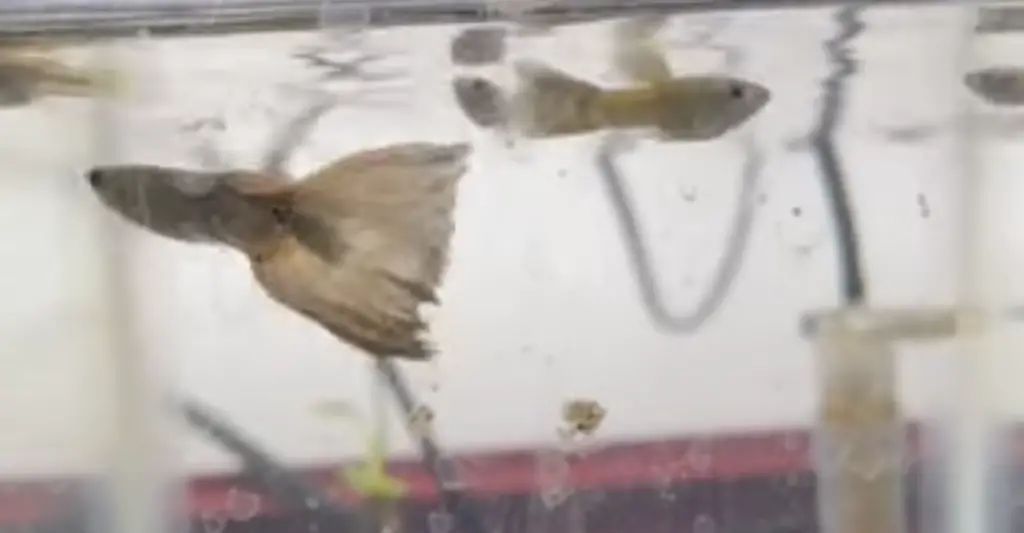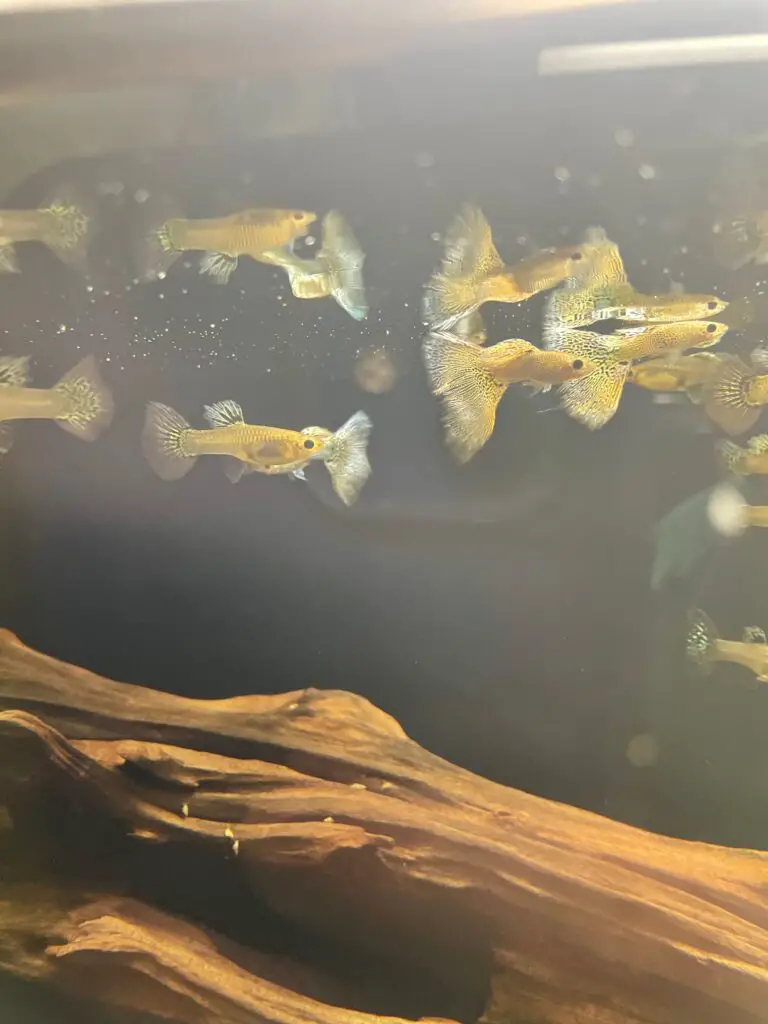Are you ready to dive into the mesmerizing world of fishkeeping and create a vibrant aquatic community? Combining the enchanting guppies with the charming Cory catfish can bring an explosion of colors and complementing personalities to your aquarium. In this comprehensive guide, we will explore the key considerations and tips for successfully keeping these two species together, ensuring a harmonious and thriving underwater paradise.
Can you keep Cory catfish with guppies?
Absolutely! Keeping Cory catfish with guppies is a fantastic idea for both novice and experienced fishkeepers alike. These two species are known for their compatibility and peaceful nature, making them ideal tankmates. The combination of Cory catfish’s bottom-dwelling habits and guppies’ active swimming behavior creates a captivating dynamic in your aquarium.
Cory catfish, often referred to as “Corys” by fish enthusiasts, are part of the Corydoras genus, and they come in various species and color patterns. They are adored for their charming personalities, cute appearance, and their endearing habit of wiggling their barbels as they explore the substrate in search of food. These bottom-dwellers have a gentle demeanor, and their peaceful nature makes them compatible with a wide range of fish species, including guppies.
Guppies, on the other hand, are some of the most popular and colorful aquarium fish, known for their vibrant hues and playful behavior. With their elegant fins and impressive variety of color patterns, they add a splash of vivacity to any tank. As livebearers, guppies give birth to live fry, making them a fascinating species to observe as they grow and interact in a community setting.
Do Cory catfish and guppies get along?
Absolutely! One of the joys of keeping Cory catfish and guppies together is witnessing their peaceful coexistence. Both species have a naturally docile temperament, and they rarely display aggressive behaviors towards each other. This compatibility allows you to create a harmonious community tank, where fish can thrive in a stress-free environment.
While guppies are known for their territorial tendencies, especially among male guppies, they generally do not direct their territorial behavior towards the Cory catfish. The peaceful nature of the Cory catfish and their tendency to stick to the bottom regions of the tank help minimize any potential conflicts.
As with any community tank, there may be occasional instances of minor skirmishes or displays of dominance, but these are usually brief and harmless. It’s essential to provide ample hiding spots and adequate space to alleviate any potential stress among the fish.
Furthermore, observing the fascinating dynamics between these two species can be a source of endless fascination for aquarium enthusiasts. Guppies’ graceful movements and vibrant colors complement the gentle wiggles and inquisitive behaviors of the Cory catfish, creating a visual symphony of aquatic life.
Understanding Water Parameters:
The first step to a successful aquarium is maintaining stable water conditions. Both guppies and Cory catfish have specific preferences when it comes to water pH and hardness. Guppies prefer slightly alkaline water, with a pH ranging from 7.0 to 7.5. On the other hand, Cory catfish thrive in a slightly more acidic environment, with a pH of 6.5 to 7.0. The general hardness (GH) of the water should be moderate, between 8 to 12 degrees.
To ensure that the water parameters stay within the optimal range, it is essential to test the water regularly using reliable test kits. Additionally, consider investing in a good water filter and perform partial water changes regularly to keep the water quality pristine.
Temperature Requirements:
In the world of fishkeeping, temperature matters! Guppies and Cory catfish are tropical fish, meaning they prefer warm water to keep them happy and healthy. Guppies like their water between 72°F to 82°F (22°C to 28°C), and the ideal range for Cory catfish is slightly lower, between 72°F to 78°F (22°C to 26°C). Keeping the temperature within these ranges will ensure both species remain active and full of life.
A reliable aquarium heater is a must to maintain a consistent temperature in your tank. Always use a thermometer to monitor the water temperature and adjust the heater settings as needed.
Creating Adequate Space:
In the vast underwater world, space matters more than you might think. For a harmonious community of guppies and Cory catfish, providing enough tank space is essential. Experts recommend a tank size of at least 10- 20 gallons to accommodate both species comfortably. Remember, the more space they have, the happier they’ll be, and it reduces the likelihood of territorial disputes.
Aquarium size is a crucial factor in fishkeeping because it directly impacts the fish’s health and behavior. In larger tanks, fish have more room to swim and establish territories, reducing stress and promoting natural behaviors. Moreover, larger water volumes are more stable and dilute waste more effectively, leading to a healthier environment overall.
Diet and Feeding: What to feed guppies and Cory catfish?
Just like us, fish have their favorite foods! Guppies are omnivorous, which means they enjoy a mix of plant-based and protein-based foods. High-quality flake or pellet food is the foundation of their diet, but they will also relish occasional treats like brine shrimp, daphnia, or freeze-dried bloodworms. Introducing some vegetable-based food into their diet will also be beneficial for their health.
Cory catfish, being bottom-dwellers, have a different diet. Their meals should consist of sinking pellets or tablets specially formulated for bottom-feeders. Now and then, treat them with live or frozen foods like bloodworms or brine shrimp to keep their taste buds happy.
Overfeeding is a common mistake among fishkeepers, leading to poor water quality and health issues for the fish. A good rule of thumb is to feed your fish in small portions, only what they can consume within a few minutes, once or twice a day. This practice ensures that the fish get enough nutrition without overloading the tank with excess food.
Will Cory catfish eat guppies?
No, Cory catfish will not eat guppies. Cory catfish are primarily bottom-feeders and are not known to be aggressive towards other fish, including guppies.
Will guppies eat Cory catfish?
No, guppies will not eat Cory catfish. Guppies are generally small and peaceful fish that primarily feed on flakes, pellets, and small live or frozen foods. They are not predatory towards Cory catfish.
Will Cory catfish eat baby guppies?
No, Cory catfish are not known to eat baby guppies. They are scavengers and mainly consume food that sinks to the substrate. Baby guppies can be at risk of being eaten by larger fish, but Cory catfish are not a concern in this regard.
Will guppies eat Cory catfish eggs?
Guppies are not known to eat Cory catfish eggs. Guppies are livebearers, meaning they give birth to live fry rather than laying eggs themselves. Cory catfish, on the other hand, lay eggs, which they typically guard and protect.
Providing Hiding Spots:
Even in the most vibrant communities, everyone needs their own space. To create a stress-free environment for your fishy friends, offer plenty of hiding spots in the aquarium. Live plants, rocks, and driftwood are excellent choices for creating cozy hiding places for the shy Cory catfish. Guppies, on the other hand, will appreciate some open swimming spaces amid the plants to showcase their lively colors.
Hiding spots are essential for the well-being of fish as they provide shelter from potential threats and reduce stress. Moreover, live plants not only offer hiding places but also contribute to water quality by absorbing excess nutrients and producing oxygen.
Avoiding Overcrowding:
In the bustling underwater metropolis, overcrowding can lead to problems. Maintaining a balanced and healthy ecosystem requires responsible stocking.
How many Corys and guppies can be kept in a ten-gallon tank?
A ten gallon tank has a lot of potential for a cory and guppy tank. Guppies are a great fish for smaller tanks due to them being peaceful fish and very hardy. a 10 gallon tank could hold 20-40 guppies as long as you are doing regular water changes. Unfortunately cory catfish need a little more space so with your 20-40 guppies you will only be able to keep 4-6 corys depending on the type and size.
How many Corys and guppies can be kept in a 20-gallon tank?
You would think that with twice as many gallons that you could just double how many fish can fit in the tank. While this is mostly true there are several lay outs of a 20 gallon fish tank. There is a 20 tall, 20 long, and the standard 20 gallon tank. The foot print of a tank is actually more important than how many gallons the tank can hold.
With the 20 tall and standard 20 gallon has very little effect of how many guppies you can have but has a huge effect on how many corys you can keep. The 20 tall and standard 20 gallon only have a slightly bigger foot print than a ten gallon so you will only be able to keep 1-2 more corys.
Corys are a bottom dweller for the most part so if the floor space isn’t bigger you can’t keep more of them. This is why I would suggest using the 20 long. The floor space is way bigger and you can keep 8-12 corys now. With all of the 20 gallon tanks you can keep 40-80 guppies as long as you are doing water changes.
Properly managing the number of fish in your aquarium is essential for their well-being. Overcrowding increases competition for resources, elevates stress levels, and can lead to aggressive behaviors. It also puts a strain on the filtration system, leading to poor water quality. Research the adult size of the fish you intend to keep to ensure they have enough space to grow and thrive.
Additional Information
Cory catfish and guppies natural behaviors?
Cory catfish are bottom-dwelling scavengers and spend much of their time foraging the substrate for food. They are also social fish, often seen in groups or “schools.” Guppies, on the other hand, are active swimmers and tend to explore all levels of the aquarium. Male guppies are known for their colorful displays and courting behaviors.
How big do Cory catfish get?
The size of Cory catfish varies depending on the species, but most Cory catfish reach an adult size of around 2 to 3 inches (5 to 7.5 centimeters) in length.
Panda Cory catfish size?
Panda Cory catfish (Corydoras panda) are a popular species and typically grow to around 1.5 to 2 inches (4 to 5 centimeters) in length.
Albino Cory catfish size?
Albino Cory catfish (Corydoras aeneus albino) have a similar size to other Cory catfish and usually grow to around 2 to 2.5 inches (5 to 6.5 centimeters) in length.
Combining the dazzling beauty of guppies with the delightful personalities of Cory catfish can turn your aquarium into a captivating masterpiece. Understanding their specific needs, from water parameters to diet, and creating a harmonious environment is the key to their well-being and happiness.
Observation is the key to success in fishkeeping, as each fish has its own unique traits and quirks. Pay close attention to their behaviors, and make adjustments as necessary to ensure a stress-free and thriving community. With these tips in mind, you’re now ready to embark on an enchanting journey of fishkeeping, where a symphony of colors and personalities awaits you. Happy fishkeeping


